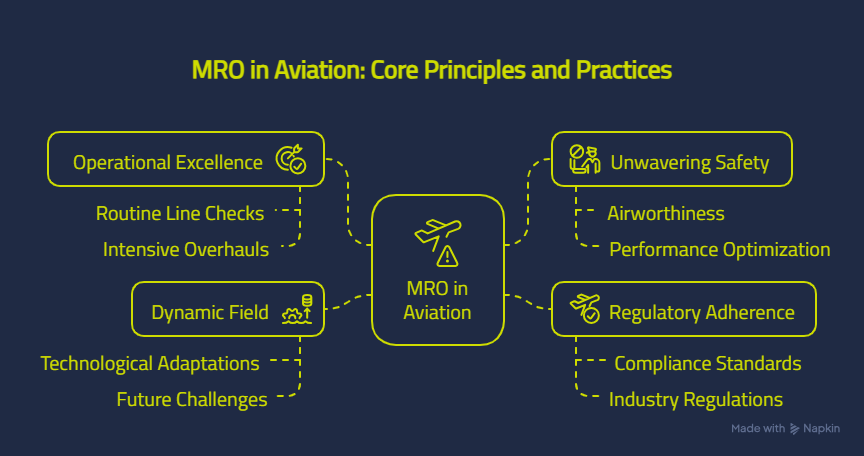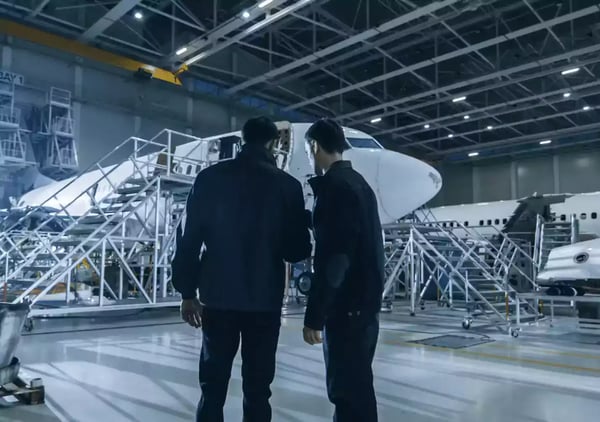Ever wondered what keeps the global fleet of aircraft, those marvels of engineering that crisscross our skies, operating safely and reliably day in and day out? While passengers might focus on the journey or the destination, behind the scenes lies a complex and critical world of meticulous care and attention. Central to this world is an acronym you'll frequently encounter: MRO.
But what is the true MRO meaning in aviation? It's far more than just a set of letters; it represents the lifeblood of aircraft operational integrity. This article aims to demystify MRO, providing a clear understanding of its fundamental functions, its profound impact on the aviation industry, and why it's a cornerstone of everything that flies.
For other, shorter articles about MRO Software, take a look at these:
- Everything you need to know about MRO Software
- 5 things to look for in MRO Software
- Gains for MROs from digital solutions
- How Airlines can tackle the complexity of MRO Software integrations
- Synchronizing MRO software with airline ERP: Unlocking key benefits
- Choosing the best MRO Software
What Exactly is MRO in the Aviation Context? The Core Definition
To grasp the significance of MRO, we first need to understand its core definition and the activities it encompasses.
Defining Maintenance, Repair, and Overhaul (MRO)
In the aviation sector, Maintenance, Repair, and Overhaul (MRO) refers to the comprehensive and integrated set of activities essential to ensure the ongoing airworthiness, safety, functionality, and optimal performance of aircraft and all their associated systems. Let's break down each component:
-
Maintenance: This is the proactive and preventive aspect of MRO. It involves a schedule of routine checks, inspections, servicing, testing, and condition monitoring designed to prevent failures before they occur. Think of it as the regular health check-ups for an aircraft. Examples include daily walk-around inspections performed by flight crews, more detailed A-checks conducted every few hundred flight hours, and other scheduled servicing tasks that keep the aircraft in peak condition.
-
Repair: This is the reactive and corrective component. When a defect, damage, or malfunction is detected—either during a scheduled maintenance check, through in-flight monitoring, or due to an unscheduled event—repair activities are initiated. This can range from replacing a minor component or patching a small dent to more significant structural repairs or system rectifications.
-
Overhaul: This is the most intensive and restorative part of MRO. Overhaul involves the complete disassembly of an aircraft, engine, or major component (like landing gear or an Auxiliary Power Unit - APU). Each part is then meticulously inspected, cleaned, repaired or replaced if necessary, and the entire unit is reassembled and tested to restore it to a condition specified by the manufacturer or regulatory authorities, often equivalent to a new or near-new state. Overhauls are typically performed at set intervals based on flight hours, flight cycles, or calendar time.
The scope of MRO is extensive, covering not only the aircraft airframe (the fuselage, wings, and tail) but also its powerplants (engines), landing gear, avionics (the complex electronic systems for communication, navigation, and surveillance), cabin interiors, and even ground support equipment (GSE) that facilitates aircraft handling on the ground. The ultimate objective of all MRO activities is to maintain aircraft in optimal condition, thereby extending their operational lifespan, ensuring unwavering compliance with stringent safety regulations, and maximizing their economic value.

Why MRO is More Than Just an Acronym: The Significance in Aviation
The familiar adage, "Safety first," is not just a slogan in aviation; it's an absolute imperative. MRO is the practical embodiment of this principle, playing a critical role that extends far beyond simple upkeep.
-
Safety: This is the paramount concern. Rigorous and meticulously executed MRO directly translates to the safety of passengers, crew, and even those on the ground. By identifying and rectifying potential issues before they escalate, MRO ensures that every flight operates under the highest possible safety standards.
-
Operational Efficiency: Well-maintained aircraft are reliable aircraft. Effective MRO minimizes unscheduled downtime, particularly costly Aircraft on Ground (AOG) situations where an aircraft is unable to fly due to a technical issue. This, in turn, helps airlines optimize flight schedules, reduce delays, and maintain passenger satisfaction.
-
Economic Viability: Aircraft are incredibly expensive assets. Proper MRO extends their revenue-generating lifespan, ensuring that airlines can maximize the return on these significant investments. Furthermore, efficient MRO practices can help manage and control maintenance costs, which constitute a substantial portion of an airline's operating expenses.
-
Regulatory Compliance: The aviation industry is one of the most heavily regulated sectors globally. National and international bodies like the FAA (Federal Aviation Administration) in the United States and EASA (European Union Aviation Safety Agency) in Europe, along with other national aviation authorities, set stringent standards for aircraft maintenance. MRO activities ensure that airlines and operators remain in full compliance with these non-negotiable airworthiness directives and regulations, avoiding penalties and maintaining their license to operate.
-
Asset Value Preservation: Just like a well-maintained car, a well-maintained aircraft retains a higher residual value. Consistent and documented MRO practices are crucial for preserving the asset value of the aircraft throughout its operational life, which is important for financing, leasing, and eventual resale
The Main Pillars: Key Components of Aviation MRO Services
Aviation MRO is not a single, monolithic activity but rather a spectrum of specialized services, each tailored to different needs and stages of an aircraft's operational cycle. Understanding these key components provides a clearer picture of the MRO meaning in aviation.
Line Maintenance: Keeping Aircraft Flight-Ready Day-to-Day
Line maintenance encompasses the routine tasks performed on an aircraft, often at the airport gate or on the ramp, between flights or during short ground stops. Its primary goal is to ensure the aircraft is fit and safe for its next scheduled flight. These tasks are typically of shorter duration and include:
-
Pre-flight and post-flight checks
-
Transit checks (when an aircraft stops briefly before continuing to another destination)
-
Daily and weekly checks
-
Fluid replenishment (oil, hydraulics, water)
-
Tire pressure checks and wheel changes if needed
-
Minor fault rectification and component replacements that don't require extensive disassembly.
Line maintenance is characterized by its high frequency and its critical role in maintaining flight schedules and ensuring rapid aircraft turnaround times.
Heavy Maintenance (Base Maintenance): In-Depth Care for Long-Term Health
Heavy maintenance, also known as base maintenance, involves more extensive and in-depth inspections, repairs, and overhauls that require the aircraft to be taken out of service for a significant period, typically in a specialized hangar facility. These checks are scheduled at longer intervals, determined by flight hours, flight cycles, or calendar time (e.g., C-checks performed every 18-24 months, D-checks every 6-10 years). Activities during heavy maintenance can include:
-
Detailed structural inspections for fatigue, corrosion, or damage.
-
Implementation of mandatory Service Bulletins (SBs) and Airworthiness Directives (ADs).
-
Major repairs and modifications.
-
Extensive component replacements and overhauls.
-
Cabin reconfigurations or refurbishments.
-
Stripping and repainting of the aircraft.
Heavy maintenance is crucial for the long-term airworthiness and structural integrity of the aircraft.
Engine MRO: Powering Aviation Safely and Efficiently
Aircraft engines are among the most complex and critical components of an aircraft, and their MRO is a highly specialized field. Engine MRO involves:
-
Complete disassembly of the engine.
-
Thorough cleaning of all parts.
-
Detailed inspection of each component using various techniques, including Non-Destructive Testing (NDT) to detect cracks or wear not visible to the naked eye.
-
Repair or replacement of worn, damaged, or life-limited parts.
-
Reassembly of the engine.
-
Rigorous testing in a specialized test cell to ensure it meets performance and safety specifications before being returned to service.
Engine MRO is performed by OEMs, airline-owned shops, or independent MRO providers with specialized facilities and expertise.
Component MRO (Non-Engine): Ensuring Reliability of Essential Systems
Beyond engines, aircraft are composed of thousands of other critical components that require specialized MRO attention. This includes:
-
Landing Gear: Overhaul of struts, wheels, brakes, and retraction systems.
-
Auxiliary Power Units (APUs): Maintenance and overhaul of these small turbine engines that provide power on the ground and backup power in flight.
-
Avionics: Testing, repair, and upgrades of communication systems, navigation equipment, flight control computers, weather radar, and cockpit displays.
-
Hydraulic and Pneumatic Systems: Maintenance of pumps, actuators, valves, and lines.
-
Flight Control Surfaces: Inspection and repair of ailerons, elevators, rudders, flaps, and slats.
Component MRO requires specialized workshops, sophisticated test equipment, and highly skilled technicians for each diverse category of parts.
Modifications and Upgrades: Enhancing Performance and Compliance
As aviation technology evolves and regulatory requirements change, aircraft often undergo modifications and upgrades. These are also considered part of the broader MRO landscape and can be driven by:
-
Regulatory Mandates: For example, the installation of new safety equipment like ADS-B Out transponders or updated TCAS (Traffic Collision Avoidance System).
-
Performance Enhancements: Such as installing winglets to improve fuel efficiency, upgrading engines, or reducing aircraft weight.
-
Passenger Experience Improvements: Including cabin refurbishments with new seats, in-flight entertainment systems, or Wi-Fi connectivity.
-
Role Changes: For instance, converting passenger aircraft into freighters (P2F conversions).
-
Technology Insertions: Upgrading older systems with newer, more capable digital technologies.
Airframe MRO: Maintaining Structural Integrity and Safety
The airframe is the structural skeleton of the aircraft, encompassing the fuselage, wings, empennage (tail assembly), and control surfaces. Airframe MRO focuses on maintaining the structural integrity and safety of these critical elements. Key aspects of airframe MRO include:
-
Scheduled Inspections: These are detailed examinations of the airframe structure to detect signs of wear, fatigue, corrosion, or damage. The frequency and depth of these inspections are typically determined by the aircraft manufacturer's maintenance program and regulatory requirements.
-
Non-Destructive Testing (NDT): NDT methods are used to inspect the airframe for hidden defects without causing damage. Common NDT techniques include ultrasonic testing, eddy current testing, magnetic particle inspection, and radiographic inspection.
-
Structural Repairs: If defects or damage are found, structural repairs are performed to restore the airframe to its original strength and airworthiness. These repairs can range from minor fixes to complex structural modifications.
-
Corrosion Prevention and Control: Aircraft are susceptible to corrosion due to environmental factors and operational conditions. Corrosion prevention and control programs involve regular inspections, cleaning, and the application of protective coatings to mitigate corrosion and repair any existing corrosion damage.
-
Modifications and Upgrades: Airframes may undergo modifications to enhance performance, improve safety, or comply with new regulatory requirements. This can include installing new avionics systems, strengthening structural components, or modifying the cabin layout.
Airframe MRO is a critical aspect of aircraft maintenance, ensuring the continued airworthiness and safety of the aircraft throughout its operational life. It requires specialized knowledge, equipment, and facilities to perform these complex tasks effectively.

The Broader Impact: MRO's Role in the Aviation Ecosystem
The significance of MRO extends throughout the entire aviation ecosystem. It's an intricate network involving airlines (who may perform MRO in-house or outsource it), independent MRO service providers, Original Equipment Manufacturers (OEMs) who design and build aircraft and components, parts suppliers and distributors, and, of course, regulatory authorities. The MRO industry is a major global employer and a significant contributor to the aviation economy. It also faces ongoing challenges such as managing complex global supply chains, developing and retaining a skilled workforce, and adapting to increasing pressures for environmental sustainability in maintenance operations.
The Evolving Meaning of MRO in the Digital Age
While the fundamental MRO meaning in aviation—ensuring safety, reliability, and compliance—remains constant, the way MRO is performed is rapidly evolving in the digital age. Technologies like predictive maintenance (using data analytics and AI to forecast component failures), digital twins (virtual replicas of physical assets), the use of drones and robotics for inspections, and augmented/virtual reality (AR/VR) for training and maintenance tasks are transforming MRO practices. These advancements don't change the core goals of MRO but significantly enhance the ability to achieve them more effectively, efficiently, and proactively. This evolution underscores the growing importance of modern MRO software and digital tools in optimizing maintenance strategies.
Conclusion
In essence, the MRO meaning in aviation encapsulates a profound commitment to operational excellence, unwavering safety, and stringent regulatory adherence. It is a multifaceted and dynamic field that forms the bedrock of reliable air travel. From routine line checks to intensive overhauls, every MRO activity is designed to keep aircraft airworthy and performing at their best. Understanding the full scope and significance of MRO is the first step towards appreciating the complex, critical work that keeps the global fleet flying safely and efficiently. As the industry continues to soar into the future, the principles and practices of MRO will remain indispensable, continually adapting to new technologies and challenges to uphold the highest standards of aviation.



 Jichen Lu
Jichen Lu
 If you are interested in knowing how you can improve your efficiency in maintenance operations, book a 30-minutes discovery call with us.
If you are interested in knowing how you can improve your efficiency in maintenance operations, book a 30-minutes discovery call with us..jpg?width=600&name=iStock-1393093359%20(1).jpg)

